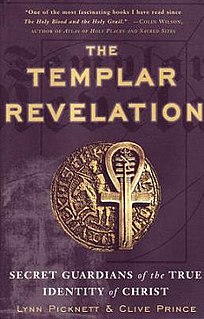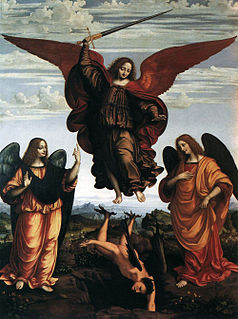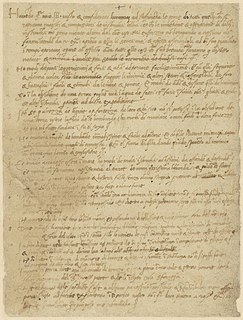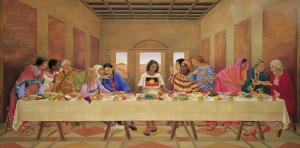The Lord's Supper may refer to:

Leonardo da Vinci was an Italian polymath of the High Renaissance who was active as a painter, draughtsman, engineer, scientist, theorist, sculptor and architect. While his fame initially rested on his achievements as a painter, he also became known for his notebooks, in which he made drawings and notes on a variety of subjects, including anatomy, astronomy, botany, cartography, painting, and paleontology. Leonardo's genius epitomized the Renaissance humanist ideal, and his collective works compose a contribution to later generations of artists matched only by that of his younger contemporary, Michelangelo.

The Last Supper is the final meal that, in the Gospel accounts, Jesus shared with his apostles in Jerusalem before his crucifixion. The Last Supper is commemorated by Christians especially on Maundy Thursday. The Last Supper provides the scriptural basis for the Eucharist, also known as "Holy Communion" or "The Lord's Supper".

The Last Supper is a late 15th-century mural painting by Italian artist Leonardo da Vinci housed by the refectory of the Convent of Santa Maria delle Grazie in Milan, Italy. It is one of the Western world's most recognizable paintings.

The Vitruvian Man is a drawing made by the Italian polymath Leonardo da Vinci in about 1490. It is accompanied by notes based on the work of the Roman architect Vitruvius. The drawing, which is in ink on paper, depicts a man in two superimposed positions with his arms and legs apart and inscribed in a circle and square.
The Last Supper refers to the last meal that Jesus Christ took with his disciples.

The Templar Revelation: Secret Guardians of the True Identity of Christ is a book written by Lynn Picknett and Clive Prince and published in 1997 by Transworld Publishers Ltd in Great Britain, Australia and New Zealand. It proposes a fringe hypothesis regarding the relationship between Jesus, John the Baptist and Mary Magdalene, and states that their true story has been suppressed by the Roman Catholic Church through, among other tactics, the conscious selection of the texts that make up the canonical New Testament, their campaigns against heresy, and their propaganda against non-Christians.

Francesco Melzi, or Francesco de Melzi (1491–1570), was an Italian painter born into a family of the Milanese nobility in Lombardy. He was one of Leonardo da Vinci’s pupils.

Leonardo da Vinci was an Italian Renaissance painter and polymath who achieved legendary fame and iconic status within his own lifetime. His renown primarily rests upon his brilliant achievements as a painter, the Mona Lisa and The Last Supper, being two of the most famous artworks ever created, but also upon his diverse skills as a scientist and inventor. He became so highly valued during his lifetime that the King of France bore him home like a trophy of war, supported him in his old age and, according to legend, cradled his head as he died.
The Da Vinci Code, a popular suspense novel by Dan Brown, generated criticism and controversy after its publication in 2003. Many of the complaints centered on the book's speculations and misrepresentations of core aspects of Christianity and the history of the Catholic Church. Additional criticisms were directed toward the book's inaccurate descriptions of European art, history, architecture, and geography.
Leonardo da Vinci (1452–1519) was an Italian Renaissance polymath.

Marco d'Oggiono was an Italian Renaissance painter and a chief pupil of Leonardo da Vinci, many of whose works he copied.

The Italian polymath Leonardo da Vinci (1452–1519) left thousands of pages of writings and drawings, but rarely made any references to his personal life. The resulting uncertainty, combined with mythologized anecdotes from his lifetime, has resulted in much speculation and interest in Leonardo's personal life. Particularly, his personal relationships, sexuality, philosophy, religion, vegetarianism, left-handedness and appearance.

The First Supper (1988) is a work of art by Susan Dorothea White, based on Leonardo da Vinci's 1490s painting The Last Supper. White's painting is acrylic on a large wood panel and, in a challenge to the patriarchal concept of thirteen men on one side of a table, shows 13 women from all regions of the world; the woman in the position of Leonardo's Christ figure is an Australian aboriginal wearing a T-shirt with the Australian Aboriginal Flag. One woman seen is in the position of Judas. She dines on a Coca-Cola and a hamburger, while all the other women are seen with a bread roll and glass of water. The painting toured Australia in the Blake Prize for Religious Art exhibition in 1988, where it was ridiculed, before being exhibited in the artist's solo exhibition in Amsterdam, where it featured in the Dutch art journal Kunstbeeld: "The work shows clearly Susan White's thinking about human rights. It should be mentioned here that she sometimes places her many faceted talent at the service of the struggle for human rights".

The Last Supper of Jesus and the Twelve Apostles has been a popular subject in Christian art, often as part of a cycle showing the Life of Christ. Depictions of the Last Supper in Christian art date back to early Christianity and can be seen in the Catacombs of Rome.

The Last Supper (1480) is a fresco depicting the Last Supper of Jesus by the Italian Renaissance artist Domenico Ghirlandaio; it is located in the refectory of the Convent of the Ognissanti on Borgo Ognissanti #42 in central Florence, region of Tuscany, Italy. It is one of three Last Supper frescoes painted by Ghirlandaio in Florence, the others being for the Badia di Passignano (1476) and for the Cenacolo di San Marco (1486).

The conservation-restoration of Leonardo da Vinci's The Last Supper is an ongoing project that has spanned many centuries. Completed in the late 15th century by the Renaissance artist Leonardo da Vinci, the mural is located in the refectory of the Convent of Santa Maria delle Grazie, Milan, Italy. The Last Supper was commissioned by Ludovico Sforza, Duke of Milan in 1495, as part of a series of renovations to the convent with the intention that the location would become the Sforza family mausoleum. Work began on The Last Supper in 1495 and lasted until 1498. The scene is understood to depict the Bible verse John 13:22, showing the reactions of the Twelve Disciples, at the Last Supper, in the moments following Jesus’s announcement that one among them will betray him.
Leonardo da Vinci School may refer to:
Leonardo da Vinci (1452–1519) was an Italian Renaissance polymath.
Jean-Pierre Isbouts is a professor in the Social Sciences PhD program of Fielding Graduate University in Santa Barbara, California, and an author, screenwriter, director, and producer of works addressing various historical periods, particularly the time period of Jesus and that of Renaissance and post-Renaissance art.